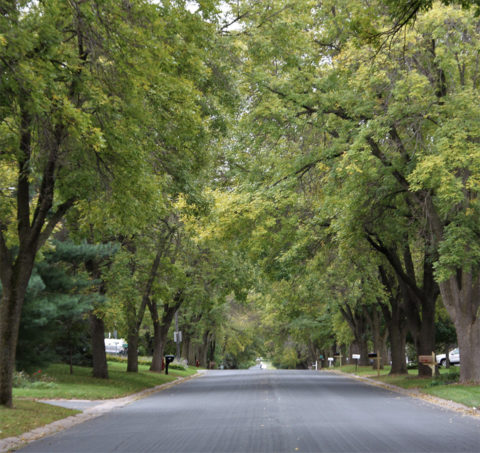Emerald ash borer confirmed in River Falls
October 16, 2019
The emerald ash borer is a wood-eating green beetle. Considered an invasive species, this beetle has recently been found in ash trees in River Falls.
It entered the U.S. back in 2002, arriving in packaging materials from China, according to the Arbor Day Foundation. The emerald ash borer has spread widely through ash tree populations, now reaching 35 states and parts of Canada, according to Nate Croes, the city forester.

(Photo by: Angelique Tretsven, Student Voice)
Croes said the bug is able to spread rapidly through the movement of firewood. Though there are firewood regulations in place, they haven’t been enforced enough to slow the spread.
The first sign of the insect in River Falls was by Dick’s market and Kwik Trip. Croes described that commercial areas are typically hit first, as seen in the neighboring town of Hudson. The trees identified in River Falls were all on private property. This spread is due to people traveling through and carrying firewood, allowing the bug to find a new home.
“We are trying to take a proactive approach and working with the city and school board,” said Jennifer Hundt, grounds supervisor on the UWRF campus. The university plans on using the same approach as the city, focusing mainly on removal of ash trees and only treating a few.
Hundt is working to get an inventory done of all the trees on campus. The university hasn’t treated any trees, since no signs have been found. “Now that we know it’s in Pierce county, we’re actually going to be working with some campus clubs and classes. Hopefully setting up some monitor boxes, the purple tents you see around,” said Hundt.
Hundt estimates over 100 ash trees are rooted in campus. “We’re going to evaluate each tree based on location, size, historical significance and overall health of the tree to begin with,” said Hundt.
More established trees may get a treatment plan. “It all comes down to budget. What are we willing to pay for, what makes sense,” said Hundt.
As far as signs of infection, Hundt described an infected tree as having a lot of leaves missing in the center of the tree, water sprouts from the ground surrounding a tree, insect damage inside of the bark, and several other indications.
Croes said the inventory of pubic trees in River Falls totals over 8,000. “We’re thinking we have about 2,000 [ash trees] right now, we’re probably on the low end because we haven't planted an ash tree since 2004, knowing emerald ash borer is coming,” said Croes.
An affected tree will die in about 3 to 5 years. Croes said only about 1% of ash trees survive when a population is hit by infestation. The beatles spend most of their lives in the tree, but emerge as adults in warmer months to mate, feeding minimally on the foliage of the ash tree.
They then lay their eggs under the bark of the tree. “That’s where, to survive the winter, they eat the bark of the tree. And that’s what does the damage. It kills the tree from the inside out,” said Croes.
The tree has to chipped after removal, since the beetle can survive in the logs. The larva can’t complete its life cycle in a wood chip. The wood chips can then be moved safely. “If we move infested wood across the city, there would be new infestations,” said Croes.
Croes said there are three options for affected areas. “You can remove the tree before its infected, you can wait until it gets infested, or there is a preventative chemical injections,” said Croes.
The chemical prevention branches into two types. In one, the roots absorb a chemical and are protected for a year. The more popular treatment is injections into the bark at the base of the tree. The insecticide injected, called emamectin benzoate, protects the tree for about 2 to 3 years. The injection costs about $10 to $12 per inch in diameter. “It’s very expensive. Our school of thought is these trees are eventually going to die, you can’t treat them forever. So we are going to do a few select trees,” said Croes.
Some residences have opted to pay for treatment of public trees near their home. The city has a database to track which trees are being treated and which will be removed. Croes said they are taking a proactive removal approach in most cases. “We’ve been doing this passively for 5 to 10 years, replacing ash trees with other species,” said Croes.
The city plans to treat specific trees, like the large ash trees on City Hall grounds. They also plan to treat trees in the center median of downtown River Falls.
Croes predicted in about five years that River Falls will start seeing more sings of damage from the emerald ash borer, based off of what other communities have experienced. Though the emerald ash borer is a concern for ash tree populations, with this focused approach the city will attempt to minimize the affects of this invasive species.
